道康宁SJ268硅酮结构胶说明书
- 格式:docx
- 大小:14.94 KB
- 文档页数:1
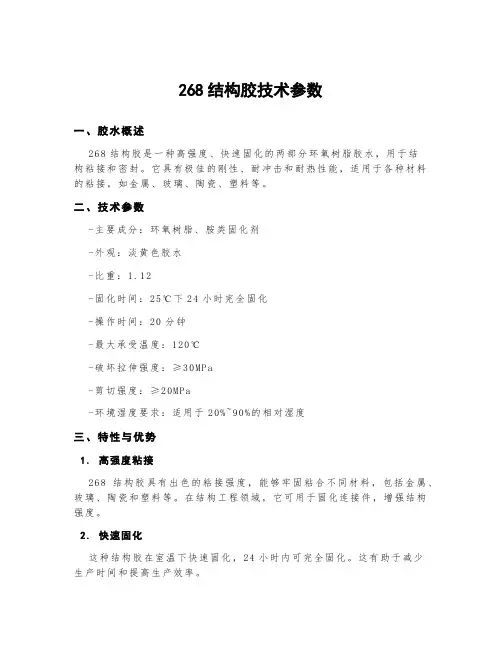
268结构胶技术参数一、胶水概述268结构胶是一种高强度、快速固化的两部分环氧树脂胶水,用于结构粘接和密封。
它具有极佳的刚性、耐冲击和耐热性能,适用于各种材料的粘接,如金属、玻璃、陶瓷、塑料等。
二、技术参数-主要成分:环氧树脂、胺类固化剂-外观:淡黄色胶水-比重:1.12-固化时间:25℃下24小时完全固化-操作时间:20分钟-最大承受温度:120℃-破坏拉伸强度:≥30MP a-剪切强度:≥20M Pa-环境湿度要求:适用于20%~90%的相对湿度三、特性与优势1.高强度粘接268结构胶具有出色的粘接强度,能够牢固粘合不同材料,包括金属、玻璃、陶瓷和塑料等。
在结构工程领域,它可用于固化连接件,增强结构强度。
2.快速固化这种结构胶在室温下快速固化,24小时内可完全固化。
这有助于减少生产时间和提高生产效率。
3.耐热性能268结构胶具有良好的耐热性能,最大可承受120℃的温度。
它适用于高温环境下的结构粘接,如汽车发动机、航空发动机等。
4.耐冲击性能该胶水具有良好的耐冲击性能,能够抵御振动和冲击载荷。
这使得使用该胶水的结构具有更高的稳定性和可靠性。
5.耐环境湿度268结构胶适用于20%~90%的相对湿度范围,能够在不同湿度环境下保持优异的粘接性能。
它可用于室内外各种环境条件下的结构粘接和密封。
四、应用领域268结构胶广泛应用于以下领域:1.汽车制造业:用于车身结构、车轮和座椅的固化粘接,提高整车结构强度和安全性。
2.航空航天领域:用于飞机、卫星等结构连接,提供优良的耐高温和耐振动性能。
3.电子器件制造:用于电路板粘合和固化,确保电子设备的稳定性和可靠性。
4.建筑业:用于玻璃幕墙安装、金属结构粘接和密封,增强建筑物的结构稳定性。
5.通用机械制造:用于各种机械设备的结构连接,提供可靠的粘接性能。
五、使用方法1.清洁表面:将需要粘接的材料表面清洁干净,确保无油脂、灰尘和污垢。
2.混合胶水:按照1:1的比例将胶水组分A和B混合均匀,搅拌2分钟。
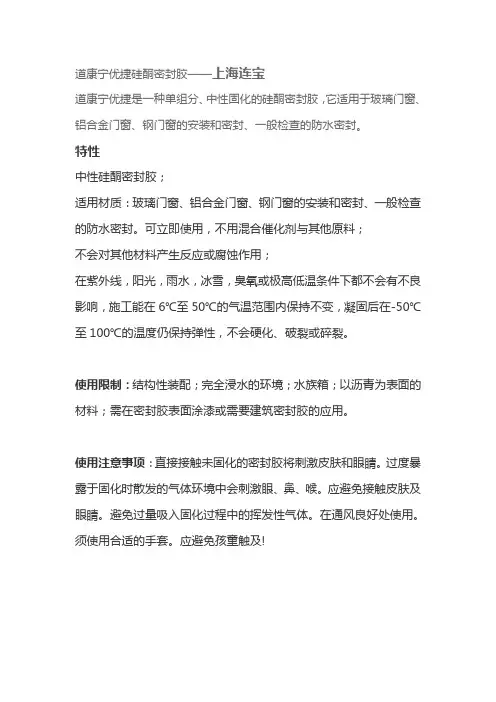
道康宁优捷硅酮密封胶——上海连宝
道康宁优捷是一种单组分、中性固化的硅酮密封胶,它适用于玻璃门窗、铝合金门窗、钢门窗的安装和密封、一般检查的防水密封。
特性
中性硅酮密封胶;
适用材质:玻璃门窗、铝合金门窗、钢门窗的安装和密封、一般检查的防水密封。
可立即使用,不用混合催化剂与其他原料;
不会对其他材料产生反应或腐蚀作用;
在紫外线,阳光,雨水,冰雪,臭氧或极高低温条件下都不会有不良影响,施工能在6℃至50℃的气温范围内保持不变,凝固后在-50℃至100℃的温度仍保持弹性,不会硬化、破裂或碎裂。
使用限制:结构性装配;完全浸水的环境;水族箱;以沥青为表面的材料;需在密封胶表面涂漆或需要建筑密封胶的应用。
使用注意事项:直接接触未固化的密封胶将刺激皮肤和眼睛。
过度暴露于固化时散发的气体环境中会刺激眼、鼻、喉。
应避免接触皮肤及眼睛。
避免过量吸入固化过程中的挥发性气体。
在通风良好处使用。
须使用合适的手套。
应避免孩童触及!。
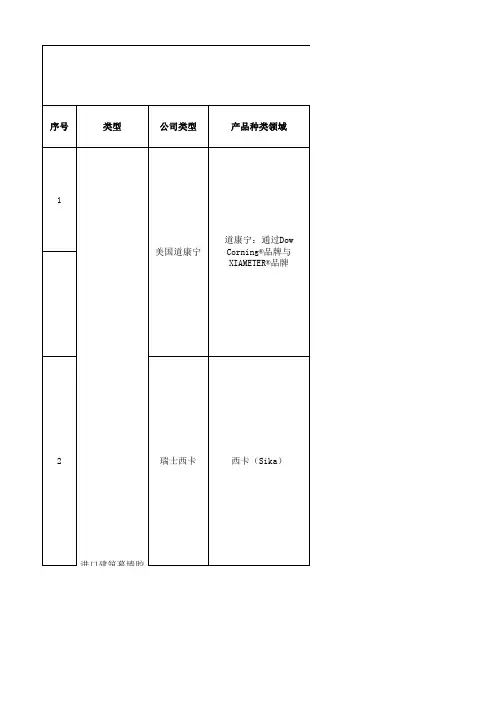
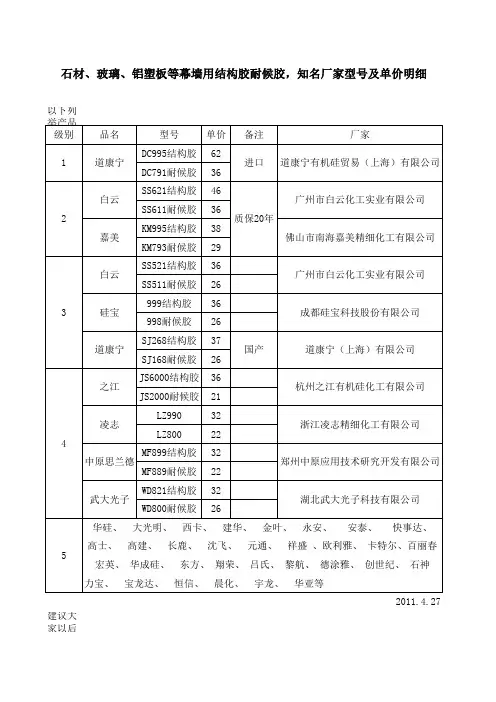
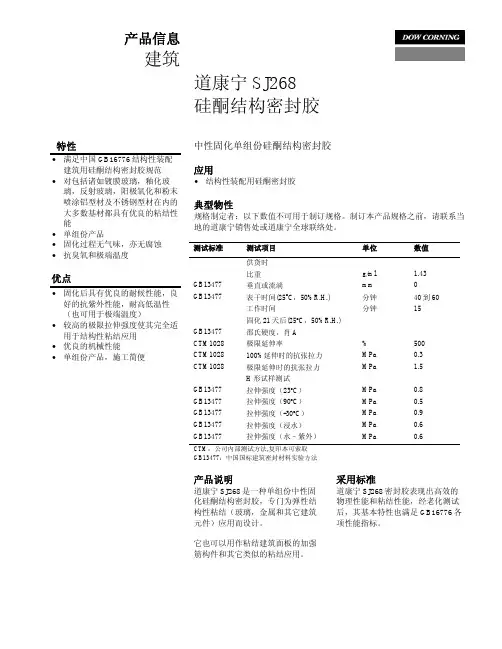
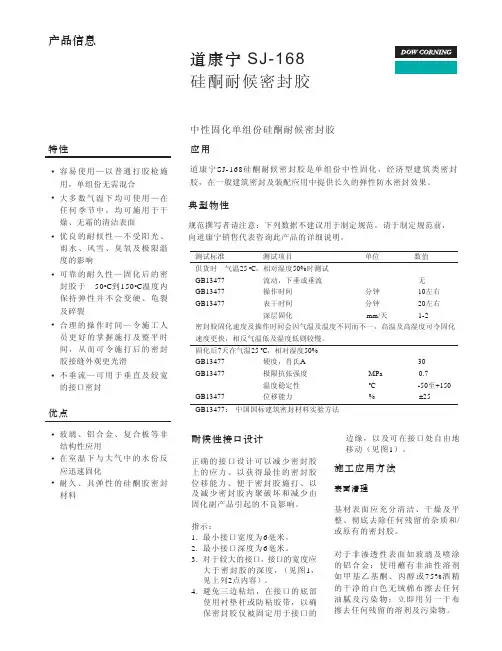
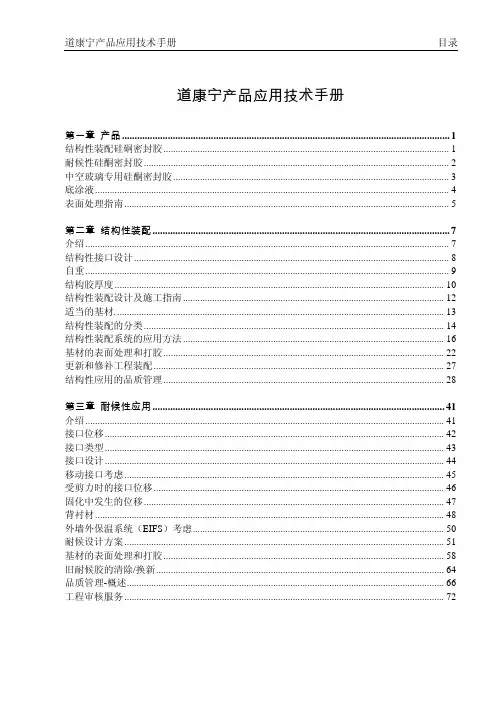
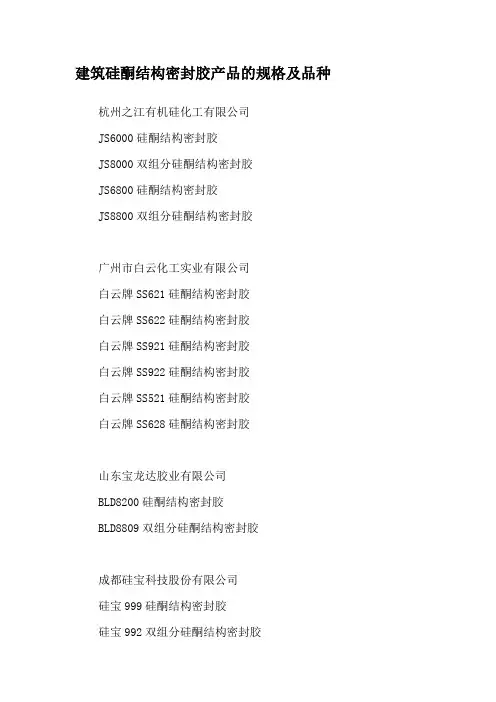
建筑硅酮结构密封胶产品的规格及品种杭州之江有机硅化工有限公司JS6000硅酮结构密封胶JS8000双组分硅酮结构密封胶JS6800硅酮结构密封胶JS8800双组分硅酮结构密封胶广州市白云化工实业有限公司白云牌SS621硅酮结构密封胶白云牌SS622硅酮结构密封胶白云牌SS921硅酮结构密封胶白云牌SS922硅酮结构密封胶白云牌SS521硅酮结构密封胶白云牌SS628硅酮结构密封胶山东宝龙达胶业有限公司BLD8200硅酮结构密封胶BLD8809双组分硅酮结构密封胶成都硅宝科技股份有限公司硅宝999硅酮结构密封胶硅宝992双组分硅酮结构密封胶广州安泰化学有限公司安泰168双组分硅酮结构密封胶安泰169硅酮结构密封胶广州市耐奇科技实业有限公司RS101单组分硅酮结构密封胶认定行胶管006号内认定字20090315-92RS102双组分硅酮结构密封胶认定行胶管006号内认定字20090315-93上海华硅化工新材料有限公司华硅牌6S硅酮结构密封胶华硅牌9S双组分硅酮结构密封胶道康宁有机硅贸易(上海)有限公司DC995建筑用硅酮结构密封胶DC993N双组分建筑用硅酮结构密封胶DC3362N双组分建筑用硅酮结构密封胶道康宁(上海)有限公司SJ268单组分建筑用硅酮结构密封胶SJ668双组分建筑用硅酮结构密封胶西卡(中国)建筑材料有限公司SG500双组分硅酮结构密封胶SG20单组分硅酮结构密封胶IG25双组分硅酮结构密封胶迈图有机硅材料(上海)有限公司SSG4400双组分硅酮结构密封胶SSG4800J单组分硅酮结构密封胶广州市新展粘胶厂SJS4200硅酮结构密封胶SJS8200双组分硅酮结构密封胶SJS9900硅酮结构密封胶SJS9909双组分硅酮结构密封胶江门大光明粘胶有限公司6018单组分建筑用硅酮结构密封胶6028双组分建筑用硅酮结构密封胶浙江凌志精细化工有限公司LZ990硅酮结构密封胶LZ992双组分硅酮结构密封胶佛山市南海区建华胶粘实业有限公司JH-3980单组分硅酮结构密封胶JH-399双组分硅酮结构密封胶佛山市南海嘉美精细化工有限公司嘉美995单组分硅酮结构密封胶嘉美国际双组分硅酮结构密封胶佛山市南海区金叶硅胶有限公司科域JSA-81 硅酮结构密封胶金叶 Kam Yip Pai(双组分)硅酮结构密封胶山东永安胶业有限公司YA8100硅酮结构密封胶YA9100双组分硅酮结构密封胶江门市快事达胶粘实业有限公司KSD9988双组分硅酮结构密封胶KSD6688硅酮结构密封胶广州市高士实业有限公司N30高士硅酮结构密封胶N60高士双组分硅酮结构密封胶佛山市高建硅胶实业有限公司高建525S双组分硅酮结构密封胶高建525硅酮结构密封胶佛山市长鹿精细化工有限公司长鹿993双组分硅酮结构密封胶长鹿995硅酮结构密封胶湖北武大光子科技有限公司WD-821高级硅酮结构密封胶WD-822双组分硅酮结构密封胶沈阳沈飞化工工业有限公司SA996硅酮结构密封胶SA989双组分硅酮结构密封胶佛山市元通胶粘实业有限公司YT9288双组分硅酮结构密封胶YT928单组分硅酮结构密封胶佛山市南海祥盛建筑材料有限公司SH9000双组分硅酮结构密封胶SH6000硅酮结构密封胶四会市欧利雅化工有限公司OLA9988双组分硅酮结构密封胶OLA8800硅酮结构密封胶佛山市卡特尔胶粘实业有限公司9900双组分建筑用硅酮结构密封胶9000硅酮结构密封胶深圳市百麗春胶粘实业有限公司EG9802硅酮建筑结构密封胶EG9800硅酮结构密封胶佛山市宏英实业有限公司4300单组分建筑用硅酮结构密封胶6300双组分建筑用硅酮结构密封胶浙江华成有机硅材料有限公司HC-9000硅酮结构密封胶HC-7000硅酮结构密封胶佛山市东方胶业实业有限公司东方196双组分硅酮结构密封胶东方195硅酮结构密封胶佛山市顺德区翔荣精细化工有限公司9002双组分建筑用硅酮结构胶9000单组分建筑用硅酮结构胶辽宁吕氏化工(集团)有限公司LS810硅酮结构密封胶LS820双组分硅酮结构密封胶沈阳黎航有机硅化工有限公司LH8000硅酮结构密封胶LH9000双组分硅酮结构密封胶佛山市顺德区德涂雅装饰材料有限公司GS822硅酮结构密封胶GS993双组分硅酮结构密封胶佛山市顺德区创世纪实业有限公司CSJ905硅酮结构密封胶CSJ9905双组分硅酮结构密封胶成都市双流新达实业有限公司石神999单组分硅酮结构密封胶石神820双组分硅酮结构密封胶郑州中原应用技术研究开发有限公司思蓝得牌MF899单组分硅酮结构密封胶思蓝得牌MF881双组分硅酮结构密封胶思蓝得牌MF899T透明硅酮结构密封胶思蓝得牌MF881F硅酮防火阻燃结构胶思蓝得牌MF899F硅酮防火阻燃结构密封胶江苏力宝建材工业有限公司DLB-7800硅酮结构密封胶DLB-7900双组分硅酮结构密封胶常熟市恒信粘胶有限公司HX-8800 硅酮结构密封胶HX-8810双组分硅酮结构密封胶扬州晨化科技集团有限公司CH-4900硅酮结构密封胶CH-5900双组分硅酮结构密封胶绵阳惠利电子材料有限公司WR7961硅酮结构密封胶WR7962双组分硅酮结构密封胶迈图有机硅材料(南通)有限公司SSG4800J硅酮结构胶认定行胶管006号外认定字20090315-94 SSG4400双组分硅酮结构密封胶认定行胶管006号外认定字20090315-95北京中天星云科技有限公司XL-1218单组分硅酮结构密封胶认定行胶管007号内认定字20090318-96XL-2218双组分硅酮结构密封胶认定行胶管007号内认定字20090318-97XL-1290单组分硅酮结构密封胶认定行胶管007号内认定字20090318-98XL-2219双组分建筑用硅酮结构密封胶认定行胶 007号内认定字20090318-99。
![DC tech_manual_asia[1] 道康宁 技术手册 硅酮胶](https://uimg.taocdn.com/ce8dac04eff9aef8941e06b9.webp)
Introduction 2 Product Offering 3Sealants 3 GlazingStructuralWeatherproofing Sealants 3Sealants 4WeatherproofingPerformanceHighPrimers 4Guide 5 PreparationSurfaceGlazing 6 StructuralSiliconeIntroduction 6Structural Joint Design 6Structural Bite 7Deadload 7Glueline Thickness 8Structural Glazing Guidelines 10SubstrateSuitability 11 Project Review Services 12 Recommendations 12 ProductGlazing 14 ClassificationStructuralofSiliconeApplication Methods for Structural Glazing Systems 16SealantandApplication 19 PreparationSurfaceGlazing 24RemedialandReplacementApplications 25Structural-QualityAssuranceDocumentation 31 Weatherproofing 37 Introduction 37Joint Movement 37Joint Types 38Joint Design 39 JointConsiderations 40 MovingShear 41inmovementJointCure 41 MovementDuringBacker Materials 42EIFS Consideration 43Examples 43 WeathersealDesignApplication 51andSealantSurfacePreparationRemoval and Replacement of Existing Weatherseals 55Quality Assurance - General 57Documentation 61Dow Corning Asia Technical ManualIntroductionThis manual is intended to provide instructions to the development of a quality assurance program for the application of Dow Corning silicone sealants for structural and weathersealing systems. As construction projects vary in many aspects, such as design, customer requirements, and environment, this manual cannot be considered a comprehensive quality assurance program for all situations.Product OfferingStructural Glazing SealantsDow Corning has a full line of high performance silicone structural sealants. These sealants should be selected based upon the unique properties that each has for specific applications:DOW CORNING 983 Silicone Glazing and Curtainwall Adhesive/SealantDescriptionDOW CORNING 983 Silicone Glazing and Curtainwall Adhesive/Sealant for structural bonding of glass, metal, and other building components. DOW CORNING 983 Silicone Glazing and Curtainwall Adhesive/ Sealant cures to a high modulus adhesive sealant with excellent adhesion to a wide range of substrates. Available in black. DOW CORNING 993 Structural Glazing SealantDescriptionDOW CORNING 993 Structural Glazing Sealant for structural bonding of glass, metal, and other building components. Meets ASTM, ISO, GB and European standard for structural glazing applications. DOW CORNING 993 Structural Glazing Sealant cures to a high modulus adhesive sealant with excellent adhesion to a wide range of substrates. Available in black.DOW CORNING 995 Silicone Structural SealantDescriptionDOW CORNING995 Silicone Structural Sealant is a one-part, medium modulus, neutral curing silicone sealant with superior unprimed adhesion for structural glazing applications. Available in black, gray and white.DOW CORNING 795 Silicone Building SealantDescriptionDOW CORNING 795 Silicone Building Sealant is a one-part, medium modulus, neutral curing silicone sealant for structural glazing and weathersealing. Available in a wide variety of colors.Weatherproofing SealantsDow Corning has a full line of high performance weatherproofing sealants. These sealants should be selected based upon the unique properties that each has for specific applications:DOW CORNING 791 Silicone Weatherproofing SealantDescriptionDOW CORNING 791 Silicone Building Sealant is a one-part, medium modulus, neutral curing silicone sealant for general weathersealing applications. Available in a wide variety of colors.DOW CORNING 790 Silicone Building SealantDescriptionDOW CORNING 790 Silicone Building Sealant is a one-part, low modulus, neutral curing silicone sealant for use in high movement weathersealing applications. DOW CORNING 790 Silicone Building Sealant has excellentprimerless adhesion to concrete and most porous substrates. Available in a wide variety of colors.DOW CORNING 793T Silicone Glazing SealantDescriptionDOW CORNING 793T Silicone Glazing Sealant is a one-part, neutral curing silicone sealant for use in bolted glazing application or any non-structural applications that translucent color is required. Available only in translucent color.High Performance Weatherproofing SealantsDOW CORNING 991 Silicone Building Sealant H. P.DescriptionDOW CORNING 991 Silicone Building Sealant H. P. is a one-part, medium modulus, neutral curing silicone sealant designed specifically for the weathersealing of sensitive substrates where the aesthetic performance of the sealant is important. The sealant is intended for porous natural stone and panels systems where staining and residue rundown streaking must be minimized.PrimersDow Corning has a full line of high performance primers for sealants. Primers are used to enhance adhesion of sealants to specific substrates.DOW CORNING 1200 Prime CoatDescriptionDOW CORNING 1200 Prime Coat is a one part, solvent based, silane primer for use with Dow Corning Sealants in many applications. Available in clear and red.DOW CORNING 1205 Prime CoatDescriptionDOW CORNING 1205 Prime Coat is a one part, solvent based, film-forming primer for use with Dow Corning Sealant on plastics and other substrates.DOW CORNING Primer CDescriptionDOW CORNING Primer C is a one-part, film forming primer for use with Dow Corning Sealants on painted and plastic surfaces to promote fast adhesion.Surface Preparation GuideSubstrate DC791 DC795 DC991 DC983 DC993 DC995 BrickNP-1 NP-1 NP-1 NA NA NA ConcreteP-1 P-1 P-3 NA NA NA MortarP-1P-1P-3NANA NA EIFS NP-1 NP-1 NP-1 NA NA NA Granite NP-1 NP-1 NP-1 NP-1 NP-1 NP-1 Travertine P-1 P-1 P-1 NA NA NA Marble P-1 P-1 P-1 NA NA NA Limestone P-1 P-1 P-1 NA NA NA GlassNP-2 NP-2 NP-2 NP-2 NP-2 NP-2 Ceramic Tile NP-2 NP-2NP-2NP-2 NP-2 NP-2 Reflective Glass NP-2 NP-2 NP-2 NP-2 NP-2 NP-2 Acrylic PaintNP-2 NP-2 NP-2 NP-2 NP-2 NP-2 Silicone Polyester NP-2 NP-2 NP-2 NP-2 NP-2 NP-2 Polyurethane Paint NP-2 NP-2 NP-2 NP-2 NP-2 NP-2 Polyester Powder Coating NP-2 NP-2 NP-2 NP-2 NP-2 NP-2 PVDF PaintNP-2P-2NP-2P-2P-2NP-2Alodine Aluminum NP-2 NP-2 NP-2 NP-2 NP-2 NP-2 Anodized Aluminum NP-2 NP-2 NP-2 NP-2 NP-2 NP-2 Mill Finish Aluminum NP-2NP-2NP-2NP-2NP-2 NP-2 Copper NP-2 NP-2 NP-2 NP-2NP-2NP-2LeadNP-2 NP-2 NP-2 NP-2 NP-2 NP-2 Stainless Steel P-1 P-1 NP-2 P-1 P-1 NP-2 Galvanized SteelP-1P-1NP-2 P-1P-1NP-2Surface Preparation GuideNote: Dow Corning must test all materials for adhesion in Structural applications Note: Field Adhesion Tests must be performed at the jobsite to verify sealant adhesion NP-1 = Abrade/DustNP-2 = Solvent Clean using the Two-Cloth Cleaning Method P-1 = Prime with Dow Corning 1200P-2 = Prime with Dow Corning 1200 or Primer C for Structural Applications/Test for Weatherseal ApplicationsP-3 = Prime with Dow Corning 1205 NA - Not Applicable or Not Tested DNU = Do Not UseStructural Silicone GlazingIntroductionSilicone structural glazing utilizes a high performance silicone sealant to attach glass, metal, or other panel materials to a metal frame in lieu of gaskets and mechanical attachments. The windload stresses on the facade are transferred through the structural silicone sealant to the structure of the building. The structural silicone sealant must maintain its adhesive and cohesive properties in order to support the panels under windload.Only silicone sealants are suitable for use in structural glazing applications. A considerable amount of time has been spent developing and testing silicone sealants to meet the needs of structural glazing application. Whenever a silicone sealant is used to structurally bond facade panels, a comprehensive quality control procedure must be established to assure the smooth, efficient, trouble-free completion of the project.Specific quality control procedures must be followed on all structural glazing projects in order to obtain a Dow Corning Structural Warranty.Structural Joint DesignStructural BiteStructural bite is the minimum width or contact surface of the silicone sealant on both the panel and the frame. The structural bite requirement is directly proportional to the windload on the building and the size of the glass. The higher the design windload and the larger the size of the glass, the greater the structural bite requirement. The structural bite must be sized appropriately to allow the windload on the glass or panel to be transferred to the structure. The structural bite for windload (live load) is calculated using the specified windload, glass or panel dimension and sealant design strength of 20 psi (140 kPa).Structural Bite CalculationFollowing is the calculation used to determine the required structural bite dimension:Bite (in) = 0.5 x short span length (ft) x windload (psf)12 in/ft x sealant design strength (20 psi)For example, a 4' x 8' lite of glass, exposed to a 60 psf windload requires a silicone bite of 1/2". Always round up to the nearest 1/16" and never round down.Bite (mm) = 0.5 x short span length (mm) x windload (kPa)strength(140kPa)designSealantFor example, a 1219 mm x 2438 mm lite of glass, exposed to a 2.87 kPa windload requires a silicone bite of 13 mm. Always round up to the nearest millimeter and never round down. DeadloadIn unsupported deadload designs, the weight of the panel places constant load on the sealant. Dow Corning structural sealants can support the weight of the panel or glass when used within the following guidelines:* For DOW CORNING795 Silicone Building Sealant, DOW CORNING 983 Silicone Glazing and Curtainwall Adhesive/Sealant, DOW CORNING 993 Structural Glazing Sealant and DOW CORNING 995 Silicone Structural Sealant the allowable deadload design strength is 1 psi or 7 kPa (700kg/m2)The weight of the panel divided by the total silicone contact area must not exceed 1psi, the deadload design strength of the sealant. Insulating glass unit manufacturers require deadload support for their insulating glass units.The deadload structural bite requirement (for 4 sided structural glazing case) is calculated asfollows:Bite= weight of glass in lbsglass perimeter in inches x sealant deadload design strength (1 psi)For example, a 4' by 8' lite of monolithic glass at a weight of 3.3 psf will have a weight of 105.6 lbs and a glass perimeter 288 inches. Based on a 1 psi deadload design strength, a bite of 3/8" is required.Bite= weight of glass in kgglass perimeter in meters x sealant deadload design strength (700 kg/m2)For example, a 1.219 meter by 2.438 meter lite of monolithic glass at a weight of14.8 kg/m2 will have a weight of 43.97 kg and a glass perimeter of 7.314 meters.Based on 700 kg/m2 deadload design strength, a bite of 9 mm is required.DEAD LOAD FORCEGlueline ThicknessProper glueline thickness facilitates the installation of sealant and allows reduced stress on the structural joint resulting from differential thermal movement. A minimum glueline of 6mm (1/4") is required, but as the structural bite increases, the glueline should be increased to allow the sealant to be applied easily and the panel to expand and contract when subjected to thermal movement. If structural bite requirements exceed 19mm (3/4") , the glueline thickness should be increased to a dimension greater than 6mm (1/4"). To facilitate filling of the structural joint, the bite to glueline thickness ratio should be maintained at 3 to 1 or less.All panels that are structurally glazed undergo repeated expansion and contraction due to variation in temperature. Glueline thickness must be properly designed to accommodate these movements. The thermal movement can be calculated for any panel or framing member if the length of the material, material type, (e.g. glass, aluminum) and coefficient of thermal expansion (CTE) is known.Joint movement for a particular panel can be calculated as follows:Movement (mm) = panel length (mm) x CTE (mm./mm./ o C) x temperature change (o C)For example, for a 2000mm by 2000mm high lite of glass fixed at the sill and a temperature change of 60o C, glass with a CTE of 9 x 10 -6 will show movement of 1.08 mm. Aluminum with a CTE of 23.2 x 10 -6 will move 2.78mm Differential movement between the glass and aluminum will be 2.78mm minus 1.08mm or 1.7mm.The dimension of glueline required (a) for the differential movement (b) can be calculated using the Pythagoras Theorem. Likewise, the allowable movement (b) for a particular glueline dimension (b) can also be calculated. The new glueline thickness (c) is limited by the movement capability of the sealant in shear in a structural joint configurationFor the example discussed above where differential movement of 1.7mm (b) is expected, and the sealant has an original glueline thickness of 6mm (a), the sealant will elongate to a new glueline thickness of 6.236mm (c). Extension of the sealant from 6mm to 6.236mm will be 4%.For DOW CORNING 995 Silicone Structural Adhesive and DOW CORNING 795 Silicone Building Sealant, maximum extension from thermal expansion is 15% in any structural silicone joint. For Dow CORNING 983 Silicone Glazing and Curtainwall Adhesive/ Sealant and Dow CORNING 993 Structural Glazing Sealant, maximum extension from thermal expansion is 10% in any structural silicone joint. The lower allowable movement capability in structural joints is due to the joint design, where the joint width, or glueline is less than the joint depth or structural bite. This is the reverse situation to weatherseals, which have higher movement capability.Note: Coefficients of Thermal Expansion Values for common building materials are available in the weatherproofing section of this technical manual.Note: The direction of the panel movement would also need to be considered. Consider whether thermal movement will take place in one direction due to the setting blocks preventing any downward movement of the glass panel or in the case of an unsupported system where the thermal movement can be taken by the glass in both directions. This will need to be taken into consideration when designing the sealant joint dimensions.Structural Glazing GuidelinesFollowing are general guidelines that should be followed for all structural glazing applications. All exceptions must be handled on a project specific basis and documented in writing by the Dow Corning Technical Service Representative.* The structural bite must be a minimum of 6mm (1/4").* The glueline thickness must be a minimum of 6mm (1/4").* The structural bite must be equal to or greater than the glueline thickness.* The bite to glueline ratio must be between 1:1 and 3:1.* The structural sealant joint must be able to be filled using standard sealant application procedures.* The joint design must allow the sealant exposure to air so that it can cure and obtain its ultimate physical properties.* The structural sealant joint must be fully cured and adhered prior to removing temporary fasteners in the field or moving curtainwall units in the shop.All exceptions to these guidelines must be reviewed and approved by a Dow Corning Technical Service Representative.Substrate SuitabilityWhen selecting aluminum substrates for structural glazing, the joint design and adhesion of the structural silicone must be considered. A flat surface with no gasket races, key slots, serrations or other irregularities is required. Some off-the-shelf extrusions may not be suitable for all structural glazing applications. The width of the extrusion must be adequate to achieve the calculated minimum structural bite with a suitable spacer attached.Extruded mill finish aluminum is not an appropriate surface for structural silicone application due to poor adhesion. The graphite lubricant used in the extrusion process causes a highly variable surface to which adhesion is not always predictable. Therefore, aluminum must have a minimum of an alodine finish for structural glazing applications. Anodizing and thermal set paints such as fluorocarbon and polyester powder coat, are also suitable aluminum finishes. In addition high-grade stainless steel (316) can also be specified, as verified by past adhesion tests and actual projects.Where substrates with non-typical surface finishes are specified, the customer should contact Dow Corning for specific advice. Discussion will need to take place on the durability of any substrate finish prior to its acceptance and use in structural applications. Independent confirmation of the substrates stability/durability may be required. Dow Corning's adhesion testing procedures, which confirms the adhesion characteristics of the sealant to the substrate, does not in any way verify the durability of that substrate. Contact your Dow Corning representative for further information.In addition to suitability of substrates for adhesion, gasket and accessory materialsmust be compatible with Dow Corning Sealants. The spacer material used in structural glazing must be fully compatible with the structural silicone. Based onhistorical testing, materials such as silicone, alcryn, polyurethane foam tape andmany vinyl extrusions are found to be compatible for full contact with structural silicone. Other materials such as EPDM, neoprene, santoprene, krayton and othersimilar organic materials are found to cause discoloration of light colored sealant.These materials are often approved for incidental contact with the structural siliconebut are not approved for full contact as a structural spacer material. Because slight discoloration of the lighter colored sealant will occur, typically only dark coloredsealants will be recommended for contact with these organic extrusions. Where discoloration is severe, even incidental contact may not be approvedProject Review ServicesDow Corning professionals are available to assist you in selecting the best sealant for your specific application. All Silicone Structural Glazing applications using DOW CORNING Adhesive/Sealants must be reviewed on a project specific basis by our technical service staff prior to any product selection. The review and testing must be successfully completed along with factory or site QA documentation before Dow Corning will issue a warranty. A project submission form is included with this manual for your use. Additional forms are available from any Dow Corning representative. The following services are offered by Dow Corning. Product RecommendationsAfter reviewing project drawings and specifications and having performed laboratory testing, Dow Corning will assist in the selection of the correct DOW CORNING sealant/primer and/or surface preparation for the specific application.Print ReviewGuidelines for silicone structural glazing details are provided in this section. Dow Corning must review all structural details before any approval or acceptance is given. Typical horizontal and vertical details, plus any non-typical details should be submitted for review. Also provide elevations indicating glass dimensions and design windload values for the building. Dow Corning has found that a few underlying principles are critical to consider in virtually all joint designs using silicone sealants. Dow Corning will review joints for compliance with these underlying design principles, provide suggestions or changes and/or identify limitations of the designs. It will also allow Dow Corning's technical staff to check that all components that will need to be tested as part of the project review have been supplied. This will include bonding substrates, spacers, setting blocks, gaskets etc.Adhesion TestingDow Corning will evaluate the adhesion of our product to materials representativeof those to be used on the job (i.e., glass, metal, masonry, composites, etc.) using amodified ASTM C794 peel adhesion test. All samples submitted for testing shouldbe a minimum of 200mm (8 in) in length. For example, for aluminum extrusions,supply one 200mm (8 in) sample for each sealant to be tested. For glass, onestandard 300mm by 300mm (12" by 12") sample is sufficient. Upon completion ofthis testing, Dow Corning will forward in writing, product recommendation, surface preparation, and primer recommendation (if needed). Testing takes 4 weeks fromreceipt of samples.Compatibility TestingChemically incompatible glazing accessories (gaskets, spacers, setting blocks, etc.) can lead to sealant discoloration and/or loss of sealant adhesion to the substrate. To ensure a product's suitability, Dow Corning tests the compatibility of job site representative accessory materials with its silicone sealants using ASTM Cl087. For each sealant to be tested, supply 100 mm (4 in.) minimum length of the gasket, spacer or setting block. Results of the compatibility test will be forwarded in writing. Testing takes 4 weeks from receipt of samples.Non-Stain TestingIf natural stone is being used on the project, Dow Corning can test and evaluate the performance of its sealants to determine if fluid in the sealant has the potential to migrate into porous substrates such as granite, marble, travertine and limestone. Job site representative samples of the stone need to be tested using a modified ASTM C1248 procedure. For each stone type and sealant to be tested, supply two samples of the dimension 25mm by 75mm (1" by 3") the thickness of the stone. Larger samples can be cut for testing. Testing takes approximately 35 days from receipt of samples.Other Test RequirementsDow Corning can accommodate special, non-standard testing requirements. Please consult your local Dow Corning Representative at the beginning of the project to determine whether Dow Corning is capable of such testing services. Dow Corning may charge a service fee for non-standard testing.Any review, recommendation, or statement, made on behalf of Dow Corning relating to an engineering design, architectural drawing, product formulation, end-use specification, or similar document is limited to the knowledge of product properties as determined by laboratory testing of material produced by Dow Corning. Any comments or suggestions relating to any subject other than such product properties are offered only to call to the attention of the engineer, architect, formulator, end-user or other person, considerations that may be relevant in his/her independent evaluation and determination of the appropriateness of such design, drawing, specifications, document or formula. Dow Corning assumes no responsibility for the commentsor suggestions relative to subjects other than such product properties, and expressly disclaims any warranty or responsibilities for them.Classification of Silicone Structural GlazingGlazingStructural2-SidedThis method uses structural silicone sealant to support the glass on two sides (eithervertical or horizontal edges) and utilizing mechanical support on the other two sides.Two-sided structural glazing can be fabricated in factory or on site.4-Sided Structural GlazingGlass is supported on all four sides with structural silicone. Structural silicone is used for bonding all four edges of the glass to the support frame, and the deadload can either be supported mechanically by a fin and setting block or by the structural silicone. It is generally recommended that four-sided structural glazing be performed in shop.Application Methods for Structural Glazing SystemsFactory (Shop) GlazingCurtain walls assembled in a factory environment are assembled in individual units. This system is referred to as unitized curtainwall. Factory construction of the curtainwalls provides a controlled environment where proper surface preparation and sealant application procedures can be maintained, and quality control programs can be implemented and documented. After the units are assembled and sealant has been allowed to fully cure and develop adhesion, units are shipped to the construction site where they are erected onto the building structure.Site (Field) GlazingSite glazing is a method that applies structural sealant directly at the construction site. Panels are attached to the mullions and transoms, which are already attached to the structure. Site glazing is suitable for 2-sided structural systems, but it is generally recommended that 4-sided systems are factory glazed.Temporary mechanical fasteners are required to firmly hold and prevent movement of the panels until the structural sealant is fully cured and adhered.NOTE: Special attention to cleaning and sealant application is required under the following conditions:* Occurrence of severe wind during application may cause undue stress on the curing structural silicone* Extremely high or low temperatures - optimum application temperature range is 10-35o C (50-95o F). For applications below 10o C (50o F), the potential for dew point and frost must be considered. For application in higher temperatures, sealant must not be applied when substrate temperatures are in excess of 50o C (120o F)* Rain contaminated joints - remove all moisture from the substrate surface, then solvent clean, prior to glazing.Structural Glass Systems (Bolted Glazing)The structural glass or bolted glass system generally has holes drilled at each corner of a glass element and a bolt is used to provide mechanical support for the glass and fixes the glass facade to a metallic structure which is secured to the main structural member of the building. A high quality silicone sealant is then used to provide the weatherseal between the glazing elements.As a result of recent developments in silicone sealant technology insulating glass units can also be installed using bolted glass technology. In this system a high performance silicone insulating glass sealant is used to produce the hermetic edge seal of the insulating glass units. Silicones are used due to their excellent resistance to ultra violet, which would attack organic based sealants. Furthermore, high performance, structurally capable silicone insulating glass sealants used as the hermetic edge seal can dispense with the need to drill the external glass element of the insulating glass unit. In this design the internal glass is bolted back to the main structure, while the external glass is structurally bonded to the inner glass around its perimeter.One of the latest developments in structural glass design is the elimination of the bolted system and the need to drill the glass by using structurally bonded patch plates as an alternative. Dow Corning's range of structural adhesive sealants enable the designer to do away with the cost of drilling of holes in glass and the use of very expensive stainless steel spider systems. This results in a system that has a reduced cost of manufacture, increased visibility and improved aesthetics.Structural Glass Systems are often referred to as structural glazing, which is often confused with structural silicone glazing, as both techniques use this generic term. Therefore, architects and specifiers should be sure of which system is being offered.Total Vision Systems (Fin Glazing)Total Vision or fin glazing is a system that is used to maximize the area of glass at the front of the building, reducing the visible mechanical fixings and increasing the unobstructed vision area of the facade. Total vision glazing is a two-sided structural glazing system, in which the glass is normally mechanically fixed at head and sill and the vertical edges are structurally attached to glass fins or mullions. The glass is bonded to the glass fin using Dow Corning structural silicone sealants. The structure is then made watertight using Dow Corning weathersealing sealants. This technique is widely used for lobbies, showrooms and racetracks where the unobstructed visibility is an advantage.Structural Attachment of Non-Glass MaterialsMaterials besides glass have been successfully attached to buildings with silicone sealants for many years. The benefits of structural silicone have been used with materials such as thin stone panels including granite or marble, ceramic tile, plastic and aluminum composite materials. In all cases, Dow Corning has performed extensive testing of specific materials prior to approving the use if its sealant as a structural adhesive. The durability of the non-glass material must be evaluated to determine its suitability for this application.Certain materials such as plastics may have high coefficients of thermal expansion that may cause undue stress on the structural silicone and/or bowing of the panels. Dow Corning must review all designs whether glass or non-glass materials where its sealants are used as structural adhesives.For aluminum composite materials that are mechanically attached around the perimeter and the sealant is used to attach an aluminum stiffener, Dow Corning permits glueline thickness dimensions of less than 6 mm (1/4"). In this application, there is a negligible amount of differential movement between the two aluminum components and shear stress on the sealant is minimal.。

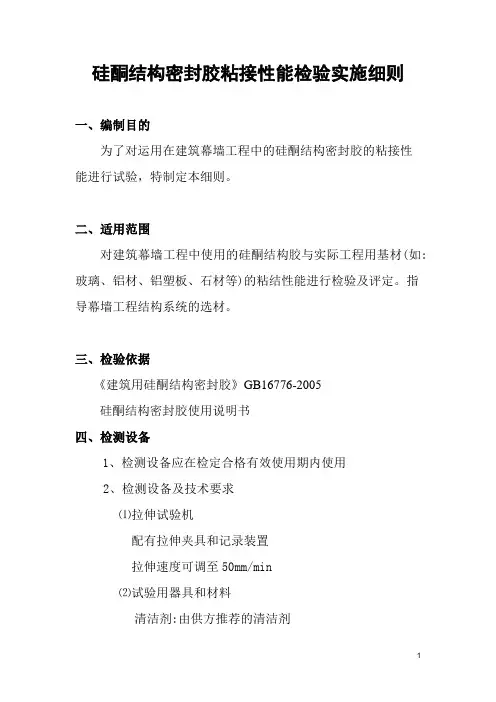
硅酮结构密封胶粘接性能检验实施细则一、编制目的为了对运用在建筑幕墙工程中的硅酮结构密封胶的粘接性能进行试验,特制定本细则。
二、适用范围对建筑幕墙工程中使用的硅酮结构胶与实际工程用基材(如:玻璃、铝材、铝塑板、石材等)的粘结性能进行检验及评定。
指导幕墙工程结构系统的选材。
三、检验依据《建筑用硅酮结构密封胶》GB16776-2005硅酮结构密封胶使用说明书四、检测设备1、检测设备应在检定合格有效使用期内使用2、检测设备及技术要求⑴拉伸试验机配有拉伸夹具和记录装置拉伸速度可调至50mm/min⑵试验用器具和材料清洁剂:由供方推荐的清洁剂隔离胶带:不粘结密封胶,带宽25mm密封胶:工程实际使用密封胶水:去离子水或蒸馏水布条:试验辅助材料基材:工程实际使用材料五、检验方法步骤1、标准试验条件温度:23±2℃、相对湿度:50±5%2、试件的制备密封胶试验样品应以包装状态下,在标准试验条件下放置24小时,样品数量不少于250g。
用丙酮或二甲苯清洗基材,干燥后备用。
要求每种基材准备两块板,并在每块基材上制备两个试件。
在粘结基材上横向放置一条隔离胶带,隔离胶带的下边距基材的下边至少75mm。
将已在标准条件下处理过的密封胶涂抹在粘结基材上,涂抹面积为100mm×75mm(包括隔离胶带),涂抹厚度约2mm。
用刮刀将密封胶涂刮在布条一端,面积为100mm×75mm,布条两面均涂,直到密封胶渗透布条为止。
将涂好的布条放在已涂密封胶的基材上,从有隔离胶带的一端开始,用玻璃棒滚压下面的布条,直至厚度均达到1.5mm为止。
3、试件的养护将制备好的试件在标准条件下进行养护:双组分试件养护14天;单组分样品养护21天养护后的试件,用锋利的刀片沿试件纵向切割4条线,每次都要切透密封胶和布条至基材表面。
留下2条25mm宽的、埋有布条的试料带,两条带的间距为10mm,除去其余部分。
将切割试料带并浸人水中处理7天,从水中取出试件后10分钟内进行剥离试验。
硅硐防霉密封胶产品说明书1、简介K-200/K-300/K-400是一种单组份,中(酸)性固化,专为各种有防霉要求(如厨房、卫生间的各种密封)而设计的硅硐密封胶。
具有优异的防霉性能,按GB/1741和ASTMC21方法测试,防霉等级为0级。
K-200/K-300/K-400特别适用于易于生长霉菌环境的接缝密封,使用时用压胶枪将胶从密封胶筒中挤到需要密封的接缝中,密封胶在室温下吸收空气的水份,固化成弹性体,形成有效密封。
2、产品特点:◆防霉性能卓越;◆单组份、使用方便,在4~40℃的温度范围内具有良好的可挤出性和触变性,用打胶枪挤出直接施工即可;◆中性固化,对金属、镀膜玻璃、混凝土、大理石、花岗岩等建筑材料无腐蚀性,应用广泛;◆固化时放出低分子醇类物质,无刺激性或难闻气味;◆优异的耐气候老化性能、耐老化、耐紫外线、而臭氧、耐水;◆耐高低温性能卓越,固化后在-50℃的低温下仍不会变脆、硬化或开裂,在150℃高温下不会变软、降解,始终保持良好的弹性;◆具有优良的粘结性,固化后与大多数建筑材料形成很强的密封而不需要使用底涂;◆与其他中性硅硐胶具有良好的相溶性。
3、主要用途:◆各类厨房用具、卫生洁具的安装及防水、防霉密封;◆各类门窗玻璃安装;◆玻璃、大理石、铝板等幕墙填缝密封;◆其他多种用途。
5、符合标准:K-200/K-300/K-400符合甚至于超过下列标准:◆企业标准Q/(NGS)PB7-1999◆美国ASTMC920-986、颜色:K-200/K-300/K-400为黑色、灰色、白色或用户要求的其他颜色;7、包装:K-200/K-300用310毫升塑料筒(净容量300ml)包装。
K-400用250亳升塑料筒(净容量240ml)包装。
8、贮存:产品必须贮存于温度为-20~27℃的阴凉干燥处,自生产日期计,K-200/K-300/K-400贮存期为9个月,请注意产品包装上的生产日期。
9、使用限制:◆不能作为结构密封胶使用;◆不宜用于所有会渗出油脂、增塑剂或溶剂的材料,如浸油木材的表面;◆不宜用于密不通风的场所,密封胶需吸收空气中的水份固化;◆不宜用于结霜或潮湿表面;◆在材料表面温度低于5℃超过40℃时不宜施工。
工业装配与维护用 DOWSIL™ 硅酮密封胶与硅酮发泡胶选择指南Consumer SolutionsIndustrial, Appliance and Maintenancepg 2DOWSIL™硅酮密封胶相比大多数有机聚合物密封胶, DOWSIL™硅基密封胶的功效更持久、功能更加多样化。
DOWSIL™密封胶是室温固化(RTV)密封胶; 可在室温下固化成坚韧的固体橡胶, 性能卓越, 并且可以满足多种多样的工业粘合与密封需求。
DOWSIL™硅酮密封度的优点包括:可在较广的使用温度范围内保持稳定性若完成正确固化, 我们的大多数产品可在-70至350°F/- 56至177°C(间歇值为400°F; 204°C)的温度范围内使用, 还有一些产品具有更高的热稳定性, 可使用温度不低于500°F; 260°C(间歇值为600°F; 315°C)工业装配与维护解决方案耐候性我们的产品具有高度的抗紫外线,即辐射和气候侵蚀的特性, 可预防硬化、开裂、破碎, 变干及变脆。
化学稳定性即使长期暴露于多种化学品及大气污染物中, 我们的密封胶也不容易降解。
良好的粘合强度我们的产品对众多工业材料均具有良好的粘合性,其中包括玻璃、陶瓷及木材、涂漆面以及许多金属和塑料。
电气性能我们的产品在设计时考虑了多种多样的应用, 能够用于各种电气及电子应用, 包括在较广温度范围内热循环的装置。
可燃性低着火时, 硅酮粘合剂/密封胶不易燃烧。
许多产品符合UL 可燃性标准。
如果您选择DOWSIL™的装配与维护产品, 您将获得拥有70多年专业知识与创新历史的全球有机硅技术领导者提供的解决方案。
工业装配与维护用 DOWSIL™硅酮密封胶与硅酮发泡胶pg 3为何选择硅酮?在实现应用的多功能性、耐久性、美感与价值方面, 硅酮胜过有机产品。
Dow 的硅酮密封胶无可匹敌, 具有以下优点:•在相同的应用中, 通常可比有机品提供三倍持久保护, 从而避免过早失效及成本高昂的修复工作 •曾在众多不同应用中获得成功, 性能可靠 •寿命周期长, 提供杰出价值•适应各种气候的应用及性能, 可对抗紫外线、臭氧、雨, 雪和极端气温•比有机产品更加耐久•即使受到拉伸或压缩也可提供持久柔韧性与粘合力•防开裂、分裂或撕裂, 不会硬化或褪色 •可在较广的温度范围内轻松应用有机物容易发生可逆反应 —— 有机聚氨酯失去其固化属性, 恢复成像口香糖一样柔软的物质。
幕墙硅酮胶性能技术参数表美国GE幕墙硅酮胶产品名称型号容量包装原产地保质期接口位移承受能力施工温度范围固化后可承受温度范围抗老化时间双组份硅酮结构胶SSG4400 208.2L 桶装日本A:18个月B:12个月±12.5% +4℃至49℃-48℃至149℃单组份硅酮结构胶SSG4800J 591.5ml 软条日本12个月±15% +4℃至49℃-48℃至180℃单给份硅酮耐候胶SCS2900 591.5ml 软条美国18个月±50% +4℃至49℃-48℃至180℃3000个小时抗污染硅酮耐候密封胶SCS9000 591.5ml 软条美国18个月±50% +4℃至49℃-48℃至149℃美国道康宁(DC)硅酮胶产品名称型号容量包装方式原产地保质期接口位移承受能力施工温度范围固化后可承受温度范围双组份硅酮结构胶DC993(原983)177.9L 桶装韩国14个月±25% -25℃至50℃-50℃至150℃单组份硅酮结构胶DC995 592 ml 软条韩国18个月±50% -25℃至50℃-50℃至150℃单组份硅酮耐候胶DC791 500 ml 软条韩国12个月±50% -25℃至50℃-50℃至150℃抗污染硅酮耐候密封胶DC991 500 ml 软条12个月±50% -29℃至50℃-50℃至150℃双组份结构胶SJ-668 203L 桶装江苏张家港14个月±10% -50℃至150℃1单组份结构胶SJ-268 590 ml 软条13个月5℃至40℃-40℃至120℃单组份耐候胶SJ-168 590 ml 软条10个月±25% -25℃至50℃-40℃至120℃广州白云幕墙硅酮胶产品名称型号容量包装产地保质期接口位移承受能力施工温度范围固化后可承受温度范围抗老化时间双组份硅酮结构胶SS622 208L 桶装广州9个月12.5±% 4℃至40℃-40℃至150℃单组份硅酮结构胶SS621 590ml 软条广州9个月25±% 4℃至40℃-50℃至150℃单组份硅酮耐候胶SS611 590 ml 软条广州9个月25±% 4℃至40℃-50℃至150℃400个小时注:1、接口位移承受能力——该性能决定于板块所承受的风压、风载力,是否在风压较大时板块因产生位移的力量将胶拉断,产生开裂,失去胶的弹性等现象。
硅酮结构胶施工操作手册1、质量标准:1.1玻璃合框后的板块厚度允许偏差:±0.5㎜1.2玻璃合框后组件长宽尺寸允许偏差:±1.01.3胶缝的宽度允许偏差:+0.5厚度允许偏差:+0.31.4胶缝饱满密实,外观光滑平整,无气泡,空隙和飞边。
1.5玻璃合框后的组件周边玻璃与铝框位置差:±1.01.6单边或两对边有副框的玻璃合框时,副框侧面与玻璃面垂直允许偏差:±30ˊ1.7随批试验件剥离粘结试验合格。
1.8玻璃饰面表面质量:a:饰面表面不能有残胶,污迹,腐蚀,裂纹等缺陷。
b:钢化玻璃表面不允许有伤痕。
c:装饰表面每平方米内划伤、擦伤,应符合下列要求。
1)0.1—0.3㎜,宽划伤,长度小于100㎜的≤4条。
2)擦伤总面积:≤300m㎡2、操作过程:2.1根据工序卡,读懂图纸和细目,不清楚时问工艺员。
2.2按领料单领料,核对组件所有的材料的规格尺寸、厚度、颜色和表面质量,发现问题及时反馈,调整、处理。
a:型材:检查长、宽尺寸,对角线差、阶差,表面质量,阶差如能用胶皮锤修平的要进行修整。
b:结构胶:检查出厂日期,批量、颜色、保质期、外观质量,结构胶与耐候胶必须配套使用,并与配套的铝型材,玻璃,单双面垫条及与它直接相接触的材料,做相容性和粘结性实验,合格后方可使用。
c:玻璃:检查长、宽尺寸、厚度颜色,外面质量。
d:单双面垫条:检查宽度,厚度,胶层质量。
e:清洗剂:丙酮,异丙醇,丁醇,二甲苯等,具体选用应按相容性粘结性试验报告指定的清理用溶剂。
f:抹布(或胶脂棉)抹布采用白色清洁、柔软、烧毛处理的棉布。
g:保护胶带,推荐采用纸基压敏胶带粘贴后容易撕胶,不留痕迹。
2.3清洗:a:用干净抹布清除玻璃和型材表面浮灰等脏物。
b:将溶剂倒出至每一块干净抹布或胶脂棉上润湿,以同一方向擦洗玻璃和铝型材的粘接面,清洗宽度为粘接棉界的1.5—2倍。
c:用第二块干的抹布或脱脂棉在溶剂挥发前,将溶剂及污物 表面沿第一块抹布或脱脂棉擦洗方向擦洗。
道康宁SJ-268硅酮结构胶——上海连宝
特性和优点•符合中国GB16776-2005 建筑用硅酮结构密封胶技术性能标准
•对包括诸如镀膜玻璃,釉化玻璃,反射玻璃,阳极氧化和粉末喷涂铝型材及不锈钢型材在内的大多数基材都具有优良的粘结性能
•固化过程无气味,亦无腐蚀
•抗臭氧和极端温度
组成•固化后具有优良的耐候性能,良好的抗紫外性能,耐高低温性(也可用于
极端温度)
•较高的极限拉伸强度使其完全适用于结构性粘结应用
•优良的机械性能
•施工简便
应用•结构性装配用硅酮密封胶
说明
DOWSIL™ SJ 268 Sealant 是一种单组分中性固化硅酮结构密封胶,专门为弹性结构性粘结(玻璃,金属和其它建筑元件)应用而设计。
它也可以用作粘结建筑面板的加强筋构件和其它类似的粘结应用。
采用标准
DOWSIL SJ 268 单组分结构性装配硅酮密封胶表现出高效的物理性能和粘结性能,经老化测试后,
其基本特性也满足GB16776-2005 各项技术性能标准。
应用方法
用于结构性装配时,DOWSIL SJ 268 Sealant 应当在工厂打胶。
在工厂打胶可以确保最佳的施工条件从而全面发挥性能。
工地打胶只限于修补工作或装配条件不允许的特殊情形。
装配条件
理想的装配应当在工厂完成并符合下列的温度和湿度条件:温度条件: 5 度到
40 度,湿度条件: 40%到60% RH。
表面清理
彻底清洁所有介面和装配区域,清除所有的污染物如油脂,机油,灰尘,霜或水汽。
所有金属,玻璃,或其它基材表面应用不脱绒的棉布,使用溶剂用“两块抹布”的清洁方法来清洁。
使用底涂液
当使用DOWSIL SJ 268 Sealant 时,请根据陶氏技术服务部的工程测试报告来决定是否使用底涂液。
关于底涂液更多资讯请联络陶氏公司各地办事处。